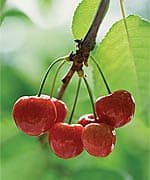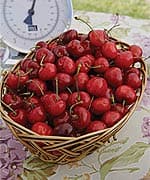Life Extension Magazine®
Powerful Pain Relief, Cancer Defense, and NeuroprotectionGrowing concerns about the gastrointestinal and cardiovascular risks of common pain-relieving drugs are leading many health-conscious adults to avidly seek safe, effective ways of beating inflammation and pain. Exciting evidence suggests that delicious tart cherries offer powerful pain relief and may also safeguard against cancer and neurodegenerative conditions.
Whether consumed fresh, frozen, or in canned or juiced forms, tart cherries are rich in nutritive compounds and powerful flavonoids. Flavonoids—colorful compounds found in many fruits and vegetables—are attracting growing attention for their antioxidative activity, free-radical scavenging capacity, and anticancer effects.1 A special class of flavonoids called anthocyanins provides tart cherries with their characteristic flavor, deep color, and diverse health benefits.2 Anthocyanins also confer dark pigmentation and strong antioxidant properties to blueberries, raspberries, and bilberries, but tart cherries offer novel anthocyanins not found in these other deeply colored fruits,3 as well as being a rich source of antioxidants including quercetin, genistein, naringenin, and chlorogenic acid.4 Relieving Pain and InflammationStrong evidence from several studies has revealed that cherry anthocyanins offer powerful relief against inflammation and pain. Scientists at Johns Hopkins Hospital in Baltimore found that tart cherry anthocyanins provided effective reduction of painful inflammation comparable to that obtained with the nonsteroidal anti-inflammatory drug, indomethacin, in an experimental animal model. The researchers believe that this remarkable effect may be derived from the anthocyanins’ ability to counter oxidative stress following an inflammatory insult.5 Tart cherry anthocyanins may also help prevent muscle pain related to intensive exercise, according to another report. Young men who incorporated tart cherry juice into their daily diet experienced reduced muscle pain following an exercise challenge, suggesting a role for tart cherries in decreasing the symptoms of exercise-induced muscle damage.6 Furthermore, cherries may offer protection against gout, a painful inflammatory condition characterized by the accumulation of sharp urate crystals in the joints. The risk of developing gout increases with high levels of urate in the blood, which can be averted with the help of cherries.7 Women who consumed just two servings of Bing cherries experienced a significant reduction in their serum urate levels together with a modest decline in two other markers of inflammation.8 Preventing and Fighting CancerIn addition to providing welcome relief from inflammation, antioxidant-rich tart cherries also hold a lot of promise in protecting against cancer.
Research has shown that a diet containing cherries is beneficial in reducing the risk of colon cancer. When scientists fed a diet containing tart cherries, anthocyanins, or cyanidin (a non-sugar breakdown product of anthocyanins) to mice with a genetic susceptibility to colon cancer, the animals developed significantly fewer and smaller colon tumors. This study also revealed that these compounds effectively reduced the growth of two human colon cancer cells lines.9 The cancer-protective benefits of this fruit were validated in another experimental study, in which cherry fruit extract reduced the growth of both human colon cancer cells and human breast cancer cells in a dose-dependent fashion.10 Researchers have suggested that a possible mechanism by which cherries may confer benefits is through shutting down the growth of cancer cells by depriving them of the proteins they need to grow.11 Supporting Melatonin Levels, Brain HealthTart cherries are one of the few food sources of melatonin, a chemical released in the body by the pineal gland that is intimately connected with circadian rhythms, or the regulation of the sleep-wake cycle. Melatonin also acts as a powerful antioxidant, providing neuroprotective and immune-modulating effects.12,13 As tart cherries provide a substantial amount of melatonin, they may constitute an important dietary source of this essential substance.14 Cherries are also rich in phenolic compounds, especially anthocyanins, which have strong neuroprotective activity. In the laboratory, cherry phenolics protected neuronal cells from cell-damaging oxidative stress in a dose-dependent manner.15 Cherry compounds may thus find important applications in protecting aging adults against neurodegenerative conditions such as memory loss, senile dementia, and perhaps even Alzheimer’s disease. Enjoying Tart CherriesTart cherries may well be the ultimate super food. But remember we are talking about tart cherries here, which usually come frozen, canned, dried, or juiced.Fresh tart cherries are seldom available at the grocery store, but may occasionally be found at a farmer’s market. Sweet cherries, which are usually consumed fresh, are nutritious, but don’t contain nearly enough anthocyanins and phenols as found in the tart varieties. Tart cherries can be enjoyed whole, used in a variety of recipes, or juiced. A tempting dessert can be made by taking the frozen variety directly from the freezer and stirring it into yogurt to create a healthy frosty treat that defeats a craving for ice cream. Tart cherries are also a delicious addition to main courses, salads, jams and jellies, and beverages. If available, fresh tart cherries should be stored in a plastic bag in the refrigerator and consumed within three days. Unopened canned cherries, on the other hand, will keep in a cool, dark cupboard for up to one year. ConclusionCherries can help adults maintain an active lifestyle by countering painful inflammation. By averting cancer and protecting the nervous system, a diet containing tart cherries may help ensure a future free from debilitating illness. Flavorful and nutritious, tart cherries thus offer important benefits for individuals seeking to live long, healthy lives. If you have any questions on the scientific content of this article, please call a Life Extension Wellness Specialist at 1-800-226-2370.
| |||||
| References | |||||
|



